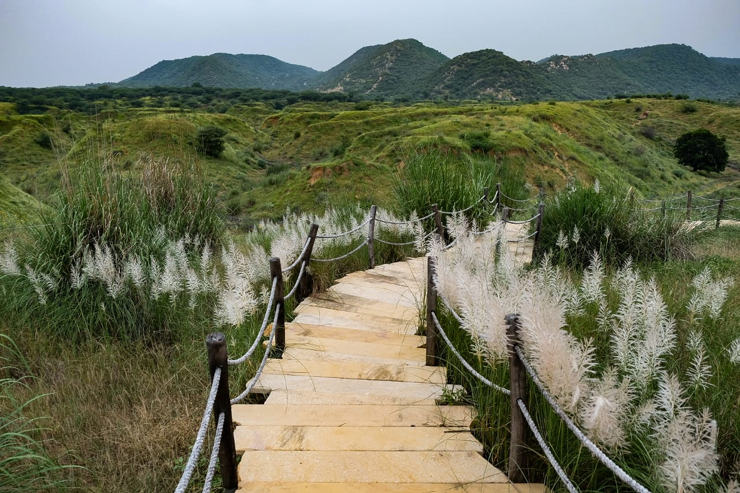The World Environment Day 2021 theme is all about ecosystem restoration—the recovery of ecosystems or the environment that has been destroyed.
It is not just about restoring, reviving and re-wilding the jungles and the big wildlife but even the city forests right next to our boundary walls—right under our noses. Surprisingly, we may not even know about our city forests even as people with dreams and passion sweat off their backs to grow a forest.
We speak with Vijay Dhasmana—an urban mali, a city gardener, an ecological gardener to understand how greenscapes can merge with urbanscapes.
Dhasmana has revived and greened barren areas in the urban sprawls of Gurgaon and Jaipur. Sometimes such efforts begin with innocent questions like, "Do you think we can plant a million trees and restore a barren piece of land in Gurgaon?" The answer was a resounding yes and work began. However, in about ten years time, about 1.20 lakh native saplings have been planted. Unbelievably, that number has birthed a forest in a barren urban landscape sandwiched between Delhi and Gurgaon.

Vijay observes the restored Gurgaon Aravallis (Photo: Priti)
Dhasmana says: "The 380-acres in Gurgaon was an abandoned mining site for quartzite and badarpur. There was no vegetation except for some keekar, not even grasses or shrubs. My heart sank a little as I checked out the enormity of the task." It was here that concerned citizens and NGOs from Gurgaon came up with rock solid support.
Gurgaon group, I Am Gurgaon (IAG), founded by Latika Thukral, Swanzal Kak Kapoor and Ambika Agarwal, provided him all the necessary support along with scores of volunteers. Collectively, they rushed to plant the right kind of trees and shrubs—native species and not decorative trees—before the monsoon clouds of 2011 began gathering.
The irony, says Dhasmana, was that the nurseries in both Haryana and Delhi did not have the trees and plants to be grown in an Aravalli forest. "We had to procure some of these plants from as far as Rajasthan, while for the rest we began collecting seeds from other similar forests. IAG marshalled students, common people and corporates to scout nearby forests for seeds and cuttings." A nursery was set up as well.
There were other challenges. Government agencies and some people and other 'bright' ideas. Some wanted a zoo, others a crocodile park while someone suggested a Singapore-style night safari. While these were shot down, the government wanted a highway right through the centre of the park.

The restored Roee habitat at Kishanbagh, Jaipur (Photo: Vijay Dhasmana)
Now, almost 10 years later, trees, shrubs and climbers have grown and created a habitat. The Aravali Biodiversity Park now looks like a forest. "It has 300 species of plants and 195 species of birds. Just imagine, that vast area could have been encroached upon and added to Delhi-Gurgaon's pollution. But now it is a paradise", says Dhasmana.
The re-wilding of the Aravali Biodiversity Park is considered a massive success.
As the work at Gurgaon was reaching its pinnacle, Dhasmana was invited to work on a Jaipur Development Authority project as an ecologist to develop the degraded Kishanbagh sand-dunes near Jaipur, close to the Nahargarh sanctuary.
Even though the terrain was the Aravallis—the same as in Gurgaon, the challenges were different, and so were the plants. Dhasmana joined the team led by noted environmentalist Pradip Krishen and once again put in his might. He also had to learn afresh about the sand dune ecology.
"Here, we had to bring alive the jungles of the Thar desert called ‘Roee’. These are grasslands and shrublands similar to the undisturbed sand dune in Jaisalmer and Barmer." The topography, the looks and scenes were totally different from that of Gurgaon Aravallis.

A restored seasonal waterbody at Kishanbagh, Jaipur (Photo: Vijay Dhasmana)
Dhasmana says: “Most of the native grasses and herbaceous plants that we planted in the Kishanbagh sand dunes are ephemeral–the plants come out in the monsoons and by the end of winter they are gone, following nature’s cycle.
Three years of efforts at the Jaipur site led to the area becoming a self-sustaining ecological system.
Dhasmana the ecologist, says that collecting the seeds of the native plants of the various differing ecosystems of the Aravallis has given him a deep insight into the world's oldest mountain range. "Now we know how to create diverse micro-habitats in city forests, including grasslands, that would support varied forms of life that are typical of northern Aravallis.”
Interestingly, both Gurgaon and Jaipur fall in the Aravallis, yet the rewilding, the ecological restoration, was different. Two forests and two different tales.

Dhasmana sensitising people on native species in Gurgaon (Photo: I Am Gurgaon)
The Aravali Biodiversity Park, Gurgaon is on the rocky hills of the Aravali, while the Kishanbagh Eco-restoration project, Jaipur is on fossil sand-dunes of the larger Aravali landscape. So, both are distinct ecologies even within the Aravallis. Therefore, the plant communities that inhabit are very different for both the areas. Even the animals, insects and birds that inhabit them are also different.
Most of the species that grow in one ecology do not grow in another. While the hilly forests are mostly woodlands and are tree-dominated, the sand-dunes are shrubland, grasslands and savannas.
Though the techniques employed for ecological restoration are fundamentally the same—creating a right palate of plant species (trees, shrubs, climbers, grasses and forbes); planting them, and taking care of them, but the difference lies in the communities of plants that you select. And, this is an effort which has to be done carefully.
The narrative about the Gurgaon forest and the Jaipur one is that if Indian cities have to fight the scourge of air pollution, water logging, seasonal health diseases and similar urban problems, they will have to protect their lands from encroachment, bring experts into the picture and involve citizens who are concerned about their land and their country.




















